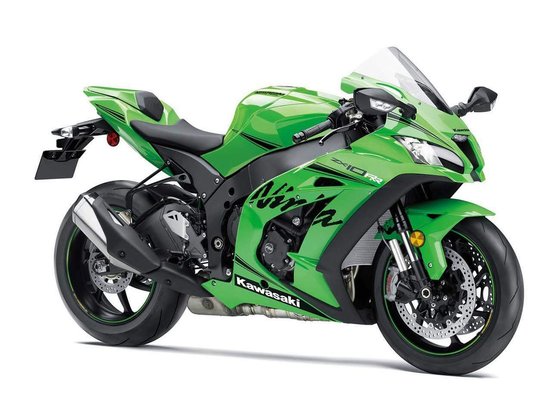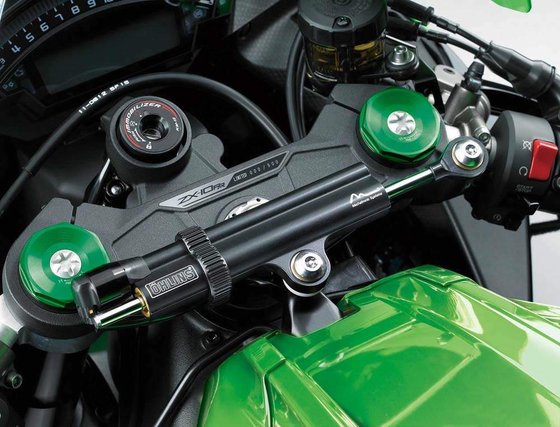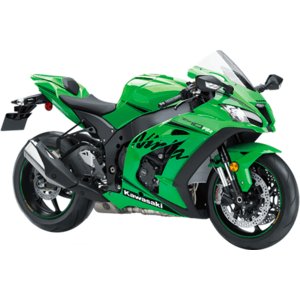Kawasaki Ninja ZX-10RR [2017–2020]: A Track Weapon Disguised as a Street Legal Machine

When Kawasaki introduced the ZX-10RR Ninja in 2017, it wasn’t just launching another superbike—it was handing riders a World Superbike Championship pedigree in a factory-wrapped package. Limited to 500 units annually, this homologation special bridges the gap between showroom floors and pit lanes, offering a visceral, unapologetic riding experience that’s as close to racing as you can get without a team garage. Having thrown a leg over a 2019 model, here’s why this machine remains a benchmark for track-day enthusiasts and why its legacy endures.
Engine: Titanium Heartbeats and Controlled Fury
At the core of the ZX-10RR lies a 998cc inline-four engine that’s been massaged with race-derived upgrades. The star of the show? Titanium connecting rods from Pankl Racing Systems. These featherweight components shave 102 grams per rod compared to steel, reducing rotational inertia by 5% and allowing the rev limiter to scream all the way to 14,100 RPM. The result? A claimed 204 PS (201 hp) under ram air—a figure that feels conservative once you’re pinned in third gear.
Power Delivery
- Low-to-Mid Range: Surprisingly tractable for a liter bike. At 6,000 RPM, the engine pulls with urgency, avoiding the “light switch” powerband of earlier models.
- Top-End Surge: From 10,000 RPM onward, the ZX-10RR transforms. The intake howl sharpens, and the horizon rushes toward you with a ferocity that’s addictive.
- Dual Injectors & Throttle Bodies: The dual-injection system (primary 47mm throttle bodies + sub-injectors) ensures seamless fueling, whether you’re crawling through traffic or hammering out of Turn 3.
The Kawasaki Quick Shifter (KQS) deserves a standing ovation. Clutchless upshifts are buttery even at 50% throttle, while auto-blip downshifts—a rarity in this era—make heel-and-toe braking feel archaic.
Chassis & Handling: Precision Meets Poise
Kawasaki’s aluminum twin-spar frame isn’t new, but revisions for the RR model—longer swingarm, steeper rake (25°), and repositioned steering head—shift weight distribution forward. Combined with Marchesini 7-spoke forged wheels, the effect is immediate: the bike flicks into corners with the urgency of a 600cc supersport, yet remains planted mid-corner.
Suspension Setup
- Front: Showa’s 43mm Balance Free Fork (BFF) uses external damping chambers to eliminate pressure fluctuations. Dial in 5 clicks of rebound, and the front end absorbs crests at Laguna Seca’s Corkscrew without a hint of wallow.
- Rear: The BFRC shock mirrors the fork’s design. Preload adjustments take seconds, and high-speed compression damping keeps the rear compliant over curbs.
Pirelli Diablo Supercorsa SP tires (120/70-17 front, 190/55-17 rear) offer grip levels that border on telepathic. Cold mornings? They’ll still warm up faster than your coffee.
Electronics: A Six-Axis Safety Net
The ZX-10RR’s Bosch IMU orchestrates a symphony of rider aids:
- S-KTRC (Traction Control): Modes 1-5 adjust slip allowed, with Mode 1 barely intruding. On damp tracks, Mode 3 is a lifesaver.
- KIBS (Cornering ABS): Braking mid-lean no longer induces panic. The system modulates pressure to avoid stand-up, letting you trail-brake deeper.
- KLCM Launch Control: Three modes manage wheelies and spin off the line. Mode 2 is ideal for street-legal drags.
Disable all aids via the left-bar controls, and the RR becomes a raw, unfiltered beast—perfect for riders who trust their reflexes more than silicon.
Design & Ergonomics: Form Follows Function

The ZX-10RR’s KRT Winter Test livery—matte black with snowflake motifs—screams “factory prototype.” The single-seat tail, devoid of passenger pegs, saves weight and screams intent.
Rider Triangle
- Seat Height: 835mm (32.9") is manageable for most, but the narrow tank lets shorter riders reach the ground confidently.
- Clip-Ons: Aggressively low, forcing a committed tuck. After 45 minutes, your wrists will protest—this isn’t a tourer.
- Wind Protection: The tiny screen deflects airflow to your collarbones. Invest in a taller Puig screen for highway blasts.
Competition: How the ZX-10RR Stacks Up
1. Yamaha YZF-R1 (2015–2020)
- Engine: Crossplane crank delivers a throatier soundtrack but lacks the Kawasaki’s top-end rush.
- Electronics: Similar IMU-based suite, but Yamaha’s TCS feels more intrusive.
- Verdict: Better street manners, but the RR dominates on stopwatch metrics.
2. BMW S1000RR (2019–2020)
- Engine: 207 hp and ShiftCam tech broaden the powerband, but it’s 8 kg heavier.
- Electronics: BMW’s Dynamic Pro mode offers more customization.
- Verdict: A tech marvel, yet lacks the RR’s analog thrill.
3. Ducati Panigale V4
- Engine: 1,103cc V4 delivers brutal torque but weighs 198 kg (dry).
- Electronics: Ducati’s Wheelie Control is superior, but reliability trails Kawasaki.
- Verdict: Exotic appeal vs. the RR’s bulletproof track focus.
Maintenance: Keeping the Beast Alive
Owners praise the ZX-10RR’s reliability, but track use demands vigilance:
Critical Service Intervals
- Oil Changes: Every 5,000 km (3,100 mi) with 10W-40 synthetic (3.3L with filter).
- Valve Clearances: Inspect every 24,000 km (15,000 mi). Shim-under-bucket design requires patience.
- Chain: OEM DID chain lasts 12,000 km with regular cleaning. Upgrade to a DID ZVM-X for track abuse.
Common Upgrades
- Brake Pads: Swap OEM Brembos for SBS Dual Carbon for bite that survives 20-lap sessions.
- Coolant: Motul Motocool Expert handles repeated 100°C+ temps.
- Suspension Fluid: Replace Showa BFF oil annually with K-Tech 5W for consistent damping.
Final Verdict
The Kawasaki Ninja ZX-10RR isn’t just a motorcycle—it’s a statement. From its titanium-kissed engine to its race-ready suspension, every component whispers, “Push harder.” While rivals offer more tech frippery, the RR’s purity and focus make it a timeless weapon for those who measure fun in lap times.
Ready to personalize yours? MOTOPARTS.store stocks everything from race-spec brake pads to lightweight sprockets. Because even perfection has room for improvement.



Specifications sheet
| Engine | |
|---|---|
| Stroke: | Four-stroke |
| Max power: | 150 kW | 201.0 hp |
| Max torque: | 116 Nm |
| Fuel system: | Fuel Injection (47mm Mikuni throttle bodies, dual injectors per cylinder) |
| Lubrication: | Forced lubrication, wet sump with oil cooler |
| Max power @: | 13500 rpm |
| Displacement: | 998 ccm |
| Max torque @: | 11500 rpm |
| Configuration: | Inline |
| Cooling system: | Liquid cooled |
| Compression ratio: | 13.0:1 |
| Number of cylinders: | 4 |
| Dimensions | |
|---|---|
| Wheelbase: | 1440 mm (56.7 in) |
| Wet weight: | 206 |
| Seat height: | 835 mm (32.9 in) |
| Overall width: | 740 mm (29.1 in) |
| Overall height: | 1145 mm (45.1 in) |
| Overall length: | 2090 mm (82.3 in) |
| Ground clearance: | 145 mm (5.7 in) |
| Fuel tank capacity: | 17 L (4.5 US gal) |
| Drivetrain | |
|---|---|
| Final drive: | chain |
| Gear ratios: | {'1st': '2.600 (39/15)', '2nd': '2.222 (40/18)', '3rd': '1.944 (35/18)', '4th': '1.722 (31/18)', '5th': '1.550 (31/20)', '6th': '1.391 (32/23)'} |
| Transmission: | 6-speed cassette-type |
| Rear sprocket: | 39 |
| Front sprocket: | 17 |
| Final reduction ratio: | 2.294 (39/17) |
| Primary reduction ratio: | 1.681 (79/47) |
| Electronics | |
|---|---|
| Rider aids: | Sport-Kawasaki TRaction Control (5 modes), Kawasaki Launch Control, Engine Brake Control |
| Instrumentation: | LCD display with gear position, power modes, and IMU data |
| Steering damper: | Electronic Öhlins steering damper |
| Maintainance | |
|---|---|
| Rear tire: | 190/55z-17 |
| Engine oil: | 10W40 |
| Front tire: | 120/70z-17 |
| Break fluid: | DOT 4 |
| Spark plugs: | NGK SILMAR9B9 |
| Spark plug gap: | 0.8–0.9 mm |
| Coolant capacity: | 2.6 |
| Forks oil capacity: | 1.2 |
| Engine oil capacity: | 3.3 |
| Engine oil change interval: | Every 5000 km or 2 years |
| Valve clearance (intake, cold): | 0.10–0.20 mm |
| Valve clearance check interval: | 24,000 km (15,000 mi) |
| Valve clearance (exhaust, cold): | 0.20–0.30 mm |
| Recommended tire pressure (rear): | 2.9 bar (42 psi) |
| Recommended tire pressure (front): | 2.5 bar (36 psi) |
| Chassis and Suspension | |
|---|---|
| Rake: | 25° |
| Frame: | Aluminum twin-spar |
| Trail: | 107 mm (4.2 in) |
| Rear brakes: | Single 220mm disc, 1-piston caliper (ABS) |
| Front brakes: | 2x 330mm Brembo M50 monobloc calipers (ABS) |
| Rear suspension: | Horizontal Back-link with BFRC gas-charged shock, preload and damping adjustable |
| Front suspension: | 43mm Showa Balance Free Fork, compression/rebound damping adjustable |
| Rear wheel travel: | 114 mm (4.5 in) |
| Front wheel travel: | 120 mm (4.7 in) |



















